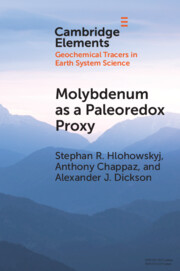Element contents
Molybdenum as a Paleoredox Proxy
Published online by Cambridge University Press: 23 August 2021
Summary
- Type
- Element
- Information
- Online ISBN: 9781108993777Publisher: Cambridge University PressPrint publication: 09 September 2021
References
Recommended Reading
Smedley and Kinniburgh (2017) provide the most extensive review of molybdenum in the natural world from solid to dissolved phases as it cycles in the environment.
Kendall et al. (2017) summarize the major concepts in the use of molybdenum isotopes as a paleoproxy and provide an excellent summary of the current research gaps concerning isotope interpretation.
Dickson (2017) covers the important and recent advances in isotope interpretations from the Phanerozoic and provides a useful synopsis complementing Kendall et al. (2017).
Helz et al. (1996) is likely the most seminal and important paper concerning the use of molybdenum as a paleoproxy. In this article Helz et al. (1996) set the stage for studying the speciation of molybdenum in ancient systems.
Scott et al. (2008) is a seminal paper illustrating the use of the molybdenum paleoproxy to understand Earth’s oxygenation and documents the power of molybdenum as a redox-sensitive tracer of past conditions.
Erickson and Helz (2000) outline the chemistry of molybdenum speciation under sulfidic redox conditions and describe the kinetics of molybdenum thiolation to help interpret both modern and ancient sedimentary systems.
Scott and Lyons (2012) identify the behavior of molybdenum across a range of redox conditions in both sediments and rocks. This paper illustrates the mechanics of molybdenum sequestration under reducing conditions and how geochemical signals can be interpreted for paleoredox reconstruction.
Algeo and Lyons (2006) address the long-standing question of the role of organic matter in association with molybdenum commonly found in ancient rocks. This paper sets the stage for future research into organic matter dynamics relating to molybdenum.
Chappaz et al. (2014) outline the burial pathways for molybdenum sequestration in sediments, commonly thought to be dominated by pyrite precipitation. They highlight current hypotheses for possible molybdenum pathways and postulate on the potential of additional sequestration pathways.
King and Pett-Ridge (2018) describe how Mo sourced from groundwater varies in concentration and isotopic composition compared to riverine inputs. This paper helps improve the understanding of isotopic cycling of Mo, strengthening the usefulness of the Mo paleoproxy by further constraining sources of variation.
Poulson Brucker et al. (2009) show empirical measurements of Mo isotopic values across a wide range of redox regimes. This work is important in that it documents major marine sediment reservoirs of Mo while providing corresponding isotopic values.
Noordmann et al. (2015) describe the importance of uranium geochemistry and its influence on Mo within sulfidic redox systems. Further, their research lays out a foundation concept of the importance of permanent stratification of a basin for the interpretation/reconstruction of paleoredox conditions.
Neely et al. (2018) outline the importance of lesser-studied Mo inputs to the oceanic pool: hydrothermal fluids. Their work demonstrates the need to include increasingly precise, although complex, considerations of all Mo inputs to the ocean budget, since the potential input of hydrothermal fluids is nontrivial.
References
- 7
- Cited by



